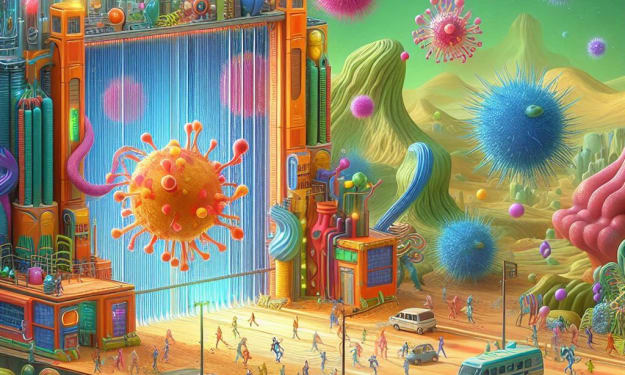The Cellular Hustle: Endocytosis & Exocytosis
A Deep Dive into How Cells Bring In, Send Out, and Keep Things Running Smoothly

The Cellular Symphony: A Dance of In and Out with Endocytosis and Exocytosis
Have you ever wondered how a cell, the microscopic building block of life, manages to bring in the nutrients it needs and expel waste products? The answer lies in a fascinating cellular ballet called endocytosis and exocytosis. These two processes work in perfect harmony to maintain a healthy cellular environment, and any disruption in this dance can lead to serious health consequences.
Endocytosis: Bringing the Outside In
Imagine a tiny Pac-Man, constantly gobbling up essential supplies. That's essentially what endocytosis is! It's the process by which a cell engulfs large molecules and particles from its surrounding environment. But unlike Pac-Man's simple chomping, endocytosis utilizes a sophisticated three-act play:
- Act I: Selection: The cell membrane acts as a bouncer, carefully choosing what enters. In some cases, like with phagocytosis, specialized finger-like projections called pseudopods extend and engulf large particles like bacteria. This targeted approach is crucial for the immune system to eliminate invaders.
- Act II: Formation: Once the target is selected, the cell membrane folds inwards, creating a bubble-like sac called a vesicle. This vesicle now houses the engulfed material. In pinocytosis, a more general form of endocytosis, the cell takes in fluids and dissolved molecules through these same vesicles.
- Act III: Delivery: The vesicle then travels within the cell, delivering its contents to the appropriate destination for processing or breakdown.
Exocytosis: Sending Messages Out
Endocytosis brings things in, but a healthy cell also needs a way to expel waste products and communicate with its neighbors. This is where exocytosis takes center stage. Picture a postman, tirelessly delivering messages. Exocytosis functions in a similar way:
- Packaging: Inside the cell, specialized compartments package molecules and waste products into vesicles. These vesicles act as tiny mail carriers, ready for delivery.
- Docking: The vesicles travel towards the cell membrane and dock at specific locations. Imagine the postman finding the correct mailbox.
- Delivery: Once docked, the vesicle fuses with the cell membrane, releasing its contents to the outside world. This allows the cell to release hormones, neurotransmitters for communication with other cells, or simply get rid of unwanted materials.
The Vital Importance of This Cellular Dance
Endocytosis and exocytosis are fundamental processes for all living things. They are crucial for:
- Nutrient Uptake: Cells need a constant supply of building blocks and energy. Endocytosis allows them to import essential molecules like glucose and amino acids.
- Immune Response: Phagocytes, white blood cells, use endocytosis to engulf and destroy bacteria and viruses, protecting the body from infection.
- Cellular Communication: Exocytosis is vital for neurons to release neurotransmitters, allowing them to send signals to other cells. This underpins all our thoughts, movements, and sensations.
- Maintaining Balance: Exocytosis also helps maintain a healthy internal environment by removing waste products that the cell can't use.
When the Dance Goes Wrong: Diseases and Disorders
Disruptions in endocytosis and exocytosis can have severe consequences. For example, in a condition called Familial Hypercholesterolemia, a genetic mutation affects the LDL receptor, a protein involved in endocytosis. This prevents the proper uptake of cholesterol-carrying LDL particles, leading to high cholesterol levels and an increased risk of heart disease.
The Future of Cellular Traffic Control
Scientists are actively researching the role of endocytosis and exocytosis in various diseases. By understanding these processes better, we may be able to develop new therapies that target specific molecules or pathways involved in cellular trafficking. Additionally, research on the potential of manipulating these processes for drug delivery holds exciting possibilities for future medical advancements.
In Conclusion
Endocytosis and exocytosis are the dynamic duo that keep our cells functioning optimally. From bringing in vital supplies to sending out messages and maintaining a clean cellular environment, these processes are the unsung heroes of cellular life. As research delves deeper into this intricate dance, we gain a greater appreciation for the remarkable complexity and efficiency that underlies all living things.
About the Creator
suren arju
Hi there! I'm Suren, your startup guide. Entrepreneur, writer, dreamer - I share insights, tips & stories to fuel your startup journey. Ready to explore, learn & win together? Join me & let's redefine how we launch, learn & leap!
Enjoyed the story? Support the Creator.
Subscribe for free to receive all their stories in your feed. You could also pledge your support or give them a one-off tip, letting them know you appreciate their work.





Comments
There are no comments for this story
Be the first to respond and start the conversation.